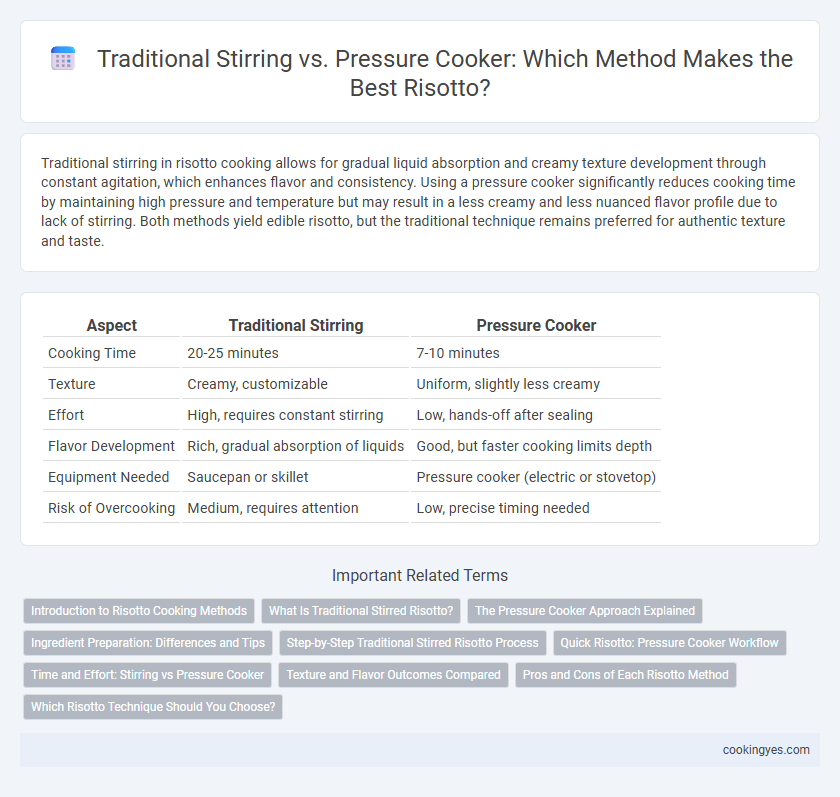Traditional stirring in risotto cooking allows for gradual liquid absorption and creamy texture development through constant agitation, which enhances flavor and consistency. Using a pressure cooker significantly reduces cooking time by maintaining high pressure and temperature but may result in a less creamy and less nuanced flavor profile due to lack of stirring. Both methods yield edible risotto, but the traditional technique remains preferred for authentic texture and taste.
Table of Comparison
| Aspect | Traditional Stirring | Pressure Cooker |
|---|---|---|
| Cooking Time | 20-25 minutes | 7-10 minutes |
| Texture | Creamy, customizable | Uniform, slightly less creamy |
| Effort | High, requires constant stirring | Low, hands-off after sealing |
| Flavor Development | Rich, gradual absorption of liquids | Good, but faster cooking limits depth |
| Equipment Needed | Saucepan or skillet | Pressure cooker (electric or stovetop) |
| Risk of Overcooking | Medium, requires attention | Low, precise timing needed |
Introduction to Risotto Cooking Methods
Traditional risotto cooking involves slowly stirring Arborio rice in broth to release starch, creating a creamy texture essential to classic risotto. Pressure cookers reduce cooking time by using high pressure to quickly infuse flavors and soften the rice while still achieving a creamy consistency. Both methods focus on balancing cooking time and texture, but traditional stirring requires constant attention, whereas pressure cookers offer convenience and efficiency.
What Is Traditional Stirred Risotto?
Traditional stirred risotto involves slowly cooking Arborio or Carnaroli rice in broth by continuously stirring to release the starch, creating a creamy texture. This method requires patience and attention, as the gradual absorption of liquid and constant agitation help achieve the characteristic silky consistency. Unlike pressure cooker techniques, traditional stirring allows for precise control over texture and flavor development in each batch.
The Pressure Cooker Approach Explained
Using a pressure cooker for risotto significantly reduces cooking time by rapidly infusing flavors and tenderizing the Arborio rice under high pressure. This method ensures a creamy texture comparable to traditional stirring but with less constant attention and energy consumption. The pressure cooker approach is ideal for quick meals while maintaining the signature rich consistency and taste of classic risotto.
Ingredient Preparation: Differences and Tips
Traditional stirring for risotto requires gradual addition of warm broth and constant stirring to release starches from the arborio rice, resulting in a creamy texture, while pressure cookers shorten cooking time by using steam pressure but demand precise liquid ratios to avoid overcooking or mushiness. Ingredient preparation for traditional methods involves finely chopped onions and preheated broth to maintain temperature consistency, whereas pressure cooker recipes recommend evenly sized ingredients and careful trimming to ensure even cooking under high pressure. Using fresh homemade broth enhances flavor in both methods, but pressure cooking benefits from reducing liquid content slightly to prevent sogginess.
Step-by-Step Traditional Stirred Risotto Process
Traditional stirred risotto requires slowly adding warm broth to Arborio rice while continuously stirring to release the starches, creating a creamy texture. Each ladle of broth is absorbed before adding the next, typically over 18 to 20 minutes, ensuring even cooking and preventing clumping. This hands-on technique controls moisture and heat precisely, resulting in an authentic creamy risotto.
Quick Risotto: Pressure Cooker Workflow
Pressure cookers reduce risotto cooking time by sealing in steam and heat, allowing rice to cook evenly and absorb flavors quickly. The Quick Risotto pressure cooker workflow involves sauteing aromatics and rice, adding broth, and sealing the cooker for a brief high-pressure cook, resulting in creamy texture without continuous stirring. This method preserves traditional risotto creaminess while significantly accelerating meal preparation.
Time and Effort: Stirring vs Pressure Cooker
Traditional risotto requires constant stirring for 18 to 20 minutes, which demands significant time and attention to achieve the creamy texture. Using a pressure cooker reduces cooking time by nearly half, around 8 to 10 minutes, while minimizing manual stirring efforts. This method streamlines the process, making risotto preparation faster and less labor-intensive without compromising flavor.
Texture and Flavor Outcomes Compared
Traditional stirring during risotto cooking promotes gradual starch release, resulting in a creamy, velvety texture and rich, layered flavors. Pressure cooker methods speed up cooking by trapping steam, often producing a firmer grain with less creamy consistency and a slightly muted flavor profile. The choice between methods impacts the balance of al dente bite and depth of taste, with traditional stirring favored for authenticity and pressure cooking valued for time efficiency.
Pros and Cons of Each Risotto Method
Traditional stirring in risotto cooking offers precise control over texture and flavor development, resulting in a creamy, well-incorporated dish but requires constant attention and time. Pressure cooker risotto significantly reduces cooking time and energy usage while preserving nutrients, though it may sacrifice some nuanced flavors and the customary creamy texture. Choosing between methods balances convenience and culinary authenticity depending on the desired outcome and available time.
Which Risotto Technique Should You Choose?
Traditional stirring for risotto ensures gradual starch release from arborio rice, creating a creamy texture and allowing precise control over cooking time and consistency. Pressure cooker risotto speeds up the process by cooking rice under high pressure, which reduces stirring but may result in a slightly less creamy texture as starch release differs. Choosing between these methods depends on whether you prioritize time efficiency with decent creaminess or the classic richness and texture achieved through patient, constant stirring.
Traditional stirring vs pressure cooker for risotto cooking Infographic

 cookingyes.com
cookingyes.com